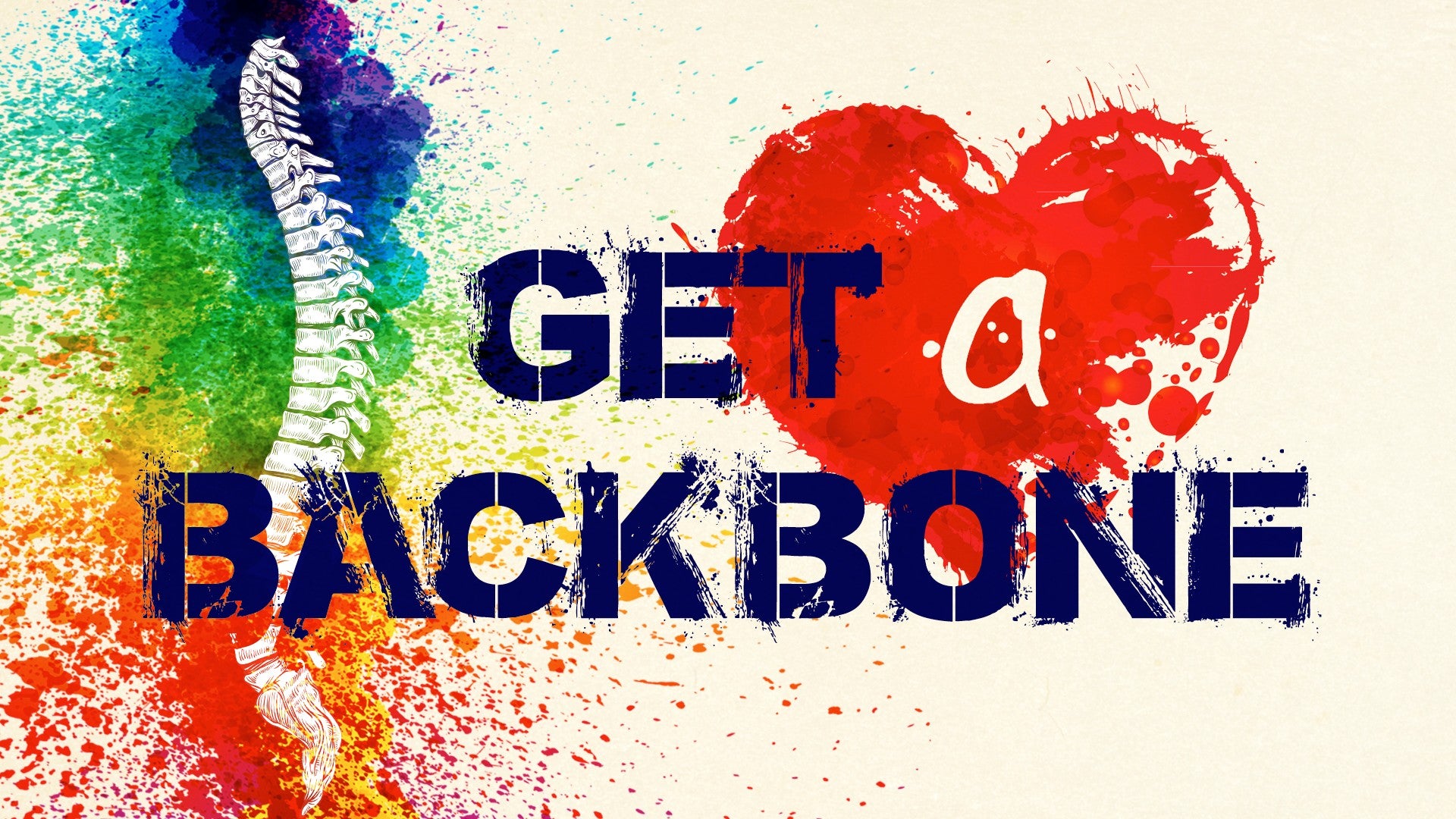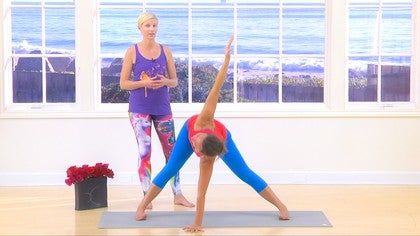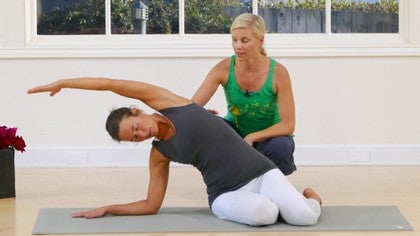Description
About This Video
Transcript
Read Full Transcript
So I'm glad to be back with Julia. I'm getting to teach her another series today. And we're gonna work with mainly with horse pose and also a little bit with a pose that I call elephant, which I got from my teachers, Susie and Paul Grilly. But we're gonna work with horse and elephant and I'm using more generic names for these poses just to kind of keep it simple today. But we're really working with somewhere along the lines of like horse pose and prostrated padottanasana, things like that.
My main connection to what I'm really trying to get you to feel today is a connection between the feet and the pelvis. And I think of the arches of the feet like a spine. So I think of the arches, it's like you have another spine down there in your arches. So trying to feel that buoyancy of the arches, the trampoline, one of my other teachers says, the trampoline of the arches of the feet. So, all right, so we're gonna start off in horse pose if you're ready.
So horse pose just feet wide and then you can turn your toes out a little bit and I don't care how much you turn your toes out or in, that does not matter. It really should just feel comfortable. You should feel stable. This isn't ballet. So the more you turn your toes out, the harder it might be to stabilize and balance.
And then you're just gonna sink yourself down and come into it. But let's actually start with, she's doing a beautiful horse, but let's start with the hands just on the thighs and leaning in. So the shoulder blades can come up by the ears. So we're starting with leaning into the bones a little bit. You don't have to have your shoulders up by the ears, but I like that feeling.
And you also might move side to side. Some people kind of like to drop one shoulder in and twist a little bit. I don't like that so much, so I don't do it very much, but do what feels right to you, make it feel good. And I like she's shifting side to side. So what I'm trying to get out of this is a groin stretch.
It's hard to stretch the groins. Actually, it's kind of a hard area to target for some people, not everybody. So hopefully you're getting a groin stretch and just really kind of sinking down, getting into the inner thighs. And this is a more intimate cue, but for just a few breaths, nobody can see you doing this. You don't know whether you're doing it or not.
But can you feel that the floor of the pelvis just spreads? Like you really just, you let the floor of the pelvis stretch. I don't think we do that often enough. So just really let everything stretch. Good.
And now start to find your feet beneath you. So you actually might even enjoy it. Give yourself a little lateral movement of just side to side, side to side movement, just allowing yourself to shift in the feet. And then just start to find yourself even in your feet. So you find yourself in a more even place.
Perfect. And now we've been leaning into the bones. Now I'm gonna ask her to bring her hands into prayer position. So she's kind of picking herself up with her muscles now, which is making it harder. So in other words, try to stay low, just bring your hands to prayer position.
And then it doesn't matter if your knees open up or anything. So she's doing a really nice job of this, but some of you might feel that you're leaning forward a little bit. If you think of the rib cage like a lampshade, we wanna put the rib cage right on top of the lampshade of the pelvis. So the pelvis is the lamp, the ribs are the lampshade. So see if you can get your ribs back a little bit, maybe your pelvis forward, and just get yourself stacked a little bit more evenly.
And then just start to lift up. So slowly come up and straighten the legs, but don't lock the knees. There's a real tendency to lock the knees. So you kind of pick yourself up again, the sensation of being sucked up through a straw and then start to bend your knees and sink down. Nice.
So let's just do this a couple more times, like three to four more times, handful more, and move nice and slow. If you go fast, you're gonna lose it. You're not gonna be getting what I'm talking about. Notice as you move up and down that you are actually moving unevenly through the feet. So could you move a little bit more evenly?
It will probably slow you down. It did slow her down. And it also makes you see that you're firing the glutes or firing the muscles of the butt unevenly. So maybe two more. I do a lot of Pilates.
I have a fabulous Pilates instructor at home that I've been working with for over a decade. And she's really made me understand that you're trying to make sure the feet fire in the same way. The feet, you press down and fire the glutes evenly. Good, and so stay in your last one. Hold it down there for just a moment.
And just a couple of breaths here. Just give yourself that sensation of really working. Try to relax a little bit. And just know that the muscles can do this. The bones can hold you up.
And then just press down through the feet and slowly rise up. So come up evenly, right up that narrow path. Good, beautiful, really nice. And now turn your toes back in towards the center. And let's give the legs a little break.
So you turn your toes back in, relax a little bit. And then bend your knees and hands to the thighs. Just slide your hands down and come all the way down till your hands get to the floor. So now bend the knees if you want to. Turn the toes out if you want to.
Let the head drop down. And just think of this pose, y'all. So most of you who've seen this pose, people are always trying to get their head on the floor. I got my head on the floor at one point in my yoga career, if you want to say that, or yoga journey. And nothing changed in my life.
So keep trying to get your head on the floor if you want to, but it's not necessarily gonna change your life. You're not gonna be enlightened if you get your head on the floor. So it doesn't really matter. So think about just feeling your pelvis, finding nice, the energy still being able to move through all the joints. So a little softness in all the joints.
And just try to really let the spine hang down. Let's use this pose, in other words, more as traction on the spine than trying to get the head to touch the floor. There's so many ways for her to cheat and get her head on the floor, right? I'm sure there is. And then a couple more breaths.
Just really let go of the back of the neck. Ah, nice. So be brave. I talk about this a lot. Be brave and try to really let go of the head and the neck and the shoulders.
For some of us, it almost feels like the head is gonna fall off. So you really, it will feel like you're being brave. So just a couple more breaths. The spine is just hanging down. We're not trying to get a stretch in the backs of the thighs necessarily.
So you can bend your knees. You can turn your toes out. If the ankles are bothering you, try to think of lifting up through the inner thighs. Pick yourself up through the inner thighs a little bit. Bring it more into the midline of the body.
Good, this beautiful, Julia. Okay, so now I'm just gonna ask you to walk your hands forward, Julia, and just come into a wide-legged down dog. It's nice, I think, sometimes to come into a wide-legged down dog. Your hands can be wider than your shoulders. You notice how her hands might be a little wider than she normally has them.
I even turn my fingers out a little bit. So whatever you wanna do, I mean, you could even turn your fingers in. You'll find a place that feels like it's right. And then what's really nice about this is, and you can even bend your knees a lot if you want to. You don't have to.
But what's nice about this is it allows some people who can't get a real stretch in the armpits and in the chest out of their down dog, sometimes this allows you to get that sensation. Just more of an opening in the front of the spine here is what we're kind of looking for. Nice, just a couple of breaths. And then just start to walk your hands back. I love that she's taking her time.
You're never in a rush. And now from here, just let the head drop down again. Relax the head. And now let's take a nice deep bend. So a deep squat, like really deep.
I got this from my four-year-old niece. So deep, but let the head drop down. Stay low. So this does not look like something a four-year-old would do. So you drop down, so it doesn't have to look pretty.
And now try to keep your head low and work your legs towards straight, towards straight. So see how much her head lifted? Okay, so bend the knees again to that deep squat, let the head drop down. And now try to keep the head low and try to work the legs towards straight. Y'all, they're not gonna straighten all the way.
And now let's try that just maybe two or three more times on your own. So what I'm trying to get to do, I don't care about stretching the hamstrings necessarily, I'm trying to get her to feel length in the spine and I'm trying to get her to find it in other areas. Like try to find the length in the spine. So imagine that your head is bungee corded to the floor, so you gotta keep your head relatively low down. And it also might allow you to feel some muscles in the pelvis and in the belly working to help you do this.
Try to keep a little weight forward into the front of the foot. Just do one more maybe if you don't mind. So it's a deep empowering squat I think. Kind of a strange rocking movement I realize, but nice, beautiful. And then you can just let yourself move laterally, side to side.
So maybe getting an inner thigh stretch. And so this movement could be fast side to side, almost like a speed skater. And it could be more muscular like a speed skater where you pick your hands up. Or it could be more gooey and luscious where you really get into stretching the inner thighs. And joy is going really nicely deep.
You don't have to be going this deep. Some people, when they just bend the knee slightly, they get a stretch of the inner thigh or groin. So don't feel like you have to go so deep. Go to where you can go. That's the best place to be.
Just a couple more shifting side to side. We don't get a lot of lateral movement in our life. We tend to walk forward. So we don't move side to side like this a lot. So it's really nice.
And again, you can feel free to speed this up, slow it down, lift your arms. And another thing, and I might get you to demonstrate this if you don't mind, Julia, is imagine that you're underneath a low table. And as you move side to side, so bend both knees. And as you move side to side, you really have to work the muscles of the legs. Gorgeous.
So this is a way to make it harder. And the next time your right knee is bent, just quarter turn to your right so you're facing the front of the mat. And just drop your back knee down. Beautiful. And now let's just get a stretch for the hip flexors.
So the hip flexors are the muscles at the front of the thigh where the pelvis and the thigh meet. So we're just trying to stretch these left hip flexors right here. It's a muscle group. So there's multiple muscles in there. So you might be feeling it in different places, but hopefully you're really feeling it where the front of the thigh meet.
Front of the thigh where the pelvis and the thigh meet. You could tuck the toes. You could bring your hands to the inside of the leg. Maybe two or three more breaths here. And it's nice, too, that she's lifting up through the front of the body.
So she's actually creating a little extension or back bend of the spine, which is going to make it more of a stretch here. Beautiful. And then just start to pick yourself up and quarter turn around. You might pause in the center for a second and let your head drop down. Relax the head.
And I love that she's moving her feet and letting her feet move. So allowing the articulation of the ankles and the joints of the feet is so important. Getting this nice traction on the spine. Remember to really let go of the head and the neck. You might just gently nod it yes or no.
And then you might add a little segment of lateral movement. So just bending one knee and then shifting side to side. And then eventually you'll bend your left knee and stay over on that side, drop the back knee down. So you also could use two blocks here. Julia doesn't need them per se.
And she's perched herself up on her fingertips. So it's almost like she has a tennis ball underneath her fingertips and she's lifting herself up. That's actually really healthy for the wrist too. Sometimes it's too much to put the wrist, the hands flat. So you could also make fists with the hands and lean into your knuckles.
That's another way to, it's perfect. Another way to just keep the wrist more flat so they're not so extended. Couple more breaths. Remember the function of what we're trying to do is stretch this. So it doesn't have to be aesthetically pleasing.
You might let your pelvis kind of tip over to one side a little bit. We're just trying to get into this area. This is an area that we don't often stretch because we sit a lot in our culture. We're sitting in the car. We're sitting at the desk.
We sit on the sofa when we get home. We sit down to dinner. So we sit a lot and these muscles get tight. Maybe last breath, let it all out. Nice productive exhale.
Good, beautiful. And then you're gonna tuck the back toes and turn back facing the center. So if you need a little lateral movement here, you can have it. We're gonna go into a little bit of anything to move the hips a little bit, always I think is good. We're just gonna take one little twist here, a spinal twist.
And you don't have to worry about the pelvis. I know some of you have been cued before to keep the pelvis level. I'm not gonna ask you to do that. And I'm not saying those people who say they're wrong. I'm gonna let you move your pelvis if you want to to stretch your spine.
So the function is we're trying to really twist the spine, give it a little stimulation and stretch. So walk your hands over towards the right side of the mat and then place your left hand wherever you want it. Some people will like it closer, the left hand closer to the foot. Other people will like it further out. So it's like further out in front of them.
And then just bring your right hand to your right hip and you might even bend your right knee or your left knee and then maybe lift your right arm up overhead. Beautiful. So it doesn't have to look pretty y'all. I want you to feel like you're ringing out your spine. I want you to feel like this is very productive.
And maybe a good cue for some of you would be able to reach the crown of the head and the pelvis in opposite directions. So you're creating length in the spine, this nice long length as you twist. And then drop that hand down and just take it over to the other side. So you notice she's letting her pelvis tilt. That's fine.
It's fine to let the pelvis tilt. Bend both knees, bend one knee if you need to. Just start to open it up. But remember, you're thinking of length, crown of the head moving away from the pelvis as you lift that top arm. Sometimes we tend to hold our breath in this position.
So make sure you're breathing. It doesn't have to be this huge, robust breath, but it could be just a nice breath. And then you can drop that hand down when you're ready. And then maybe just take one or two more each side. So I'm gonna ask Julia to do two more each side.
So you might speed this up a little bit. And if you're going faster than we are, you could do three or four each side. You know your body better than I do. You've lived in it your whole life. So you know how to find a twist that's productive for you and that feels good.
So you gotta be able to explore. That doesn't mean fidget, but you've gotta be able to explore your own body. So she's gonna do one more each side, making sure she's breathing. One of my favorite quotes from Eric Schiffman is that a good teacher should tell you what to do without telling you what to do. So I'm giving her guidance, but then I'm gonna turn her loose and let her, I'm gonna trust that she can find it.
And it looks like she's enjoying it. And that's what I wanna see in my students. If they look like they're inside their bodies and they're enjoying the movement and it's productive, that's what I wanna see. I'm not looking for it to look aesthetically pleasing so I can take a picture of them and put them on the cover of a magazine. And so last one, you'll just let the arm drop down and then just let the head hang down the center again.
Remember to breathe a little bit here and soften the knees, or not breathe a little bit, but maybe breathe a lot because sometimes we tend to hold the breath in those twists and as well, we also tend to get a little, some of us get tension in the neck and the shoulders when we twist like that. So really letting go of the head and the neck here. This is one of the few places that the head and the neck get traction. All day long, the head is compressed. We're actually a little shorter at the end of the day.
So in this moment, the skull, the brain, the weight of the brain and the skull are pulling gently down on the spine. Again, it's not about stretching the hamstrings here so I don't care if you bend your knees. And then I'm gonna get her into a place with her feet where she feels stable. So you might turn your toes out, some of you, any place that you feel more stable in your feet where you feel like you can really press down into them. So we're gonna roll the spine up slowly.
This is one of my favorite movements. And you're gonna roll up by pushing down into the back, down into the feet, sorry. And you're gonna feel as if you're wrapping your sit bones towards the floor and the belly pulls up into the spine. So the belly goes up and under the ribs and you keep wrapping the sit bones around the back of the body so that the pelvis is anchoring you. Beautiful.
Stacking the spine all the way up. Don't lock the knees at the top. Really nice. Little softness in the knees. Gorgeous.
Heel toe your feet back together for a moment. Mm-hmm. And this is gonna seem weird, but just let your feet lift up, let yourself relax. We're gonna do one more horse series, but you might just kind of shake the legs out a little bit. Let yourself move.
Sometimes we get a little too focused in all these movements, you know? All right, so we're gonna do one more series in horse. So I'm gonna ask you to step back and ask Julia to step back into a horse pose. And this is hard. You know, this pose can get hard for people.
So this time we're not going to bend down into and lean into the bones like we did before. So I'm not gonna send her down there yet because I want to tell you a couple of things. So y'all, underneath both butt cheek is a smile muscle. I'll tell you, Julia, for sure. So underneath both butt cheek is a smile, right?
Both butt has a smile. So I'm looking for you to access those muscles of, the smile muscles is what one of my teacher calls them. So it's like upper hamstring and lower glutes. So when we come into the squat, I want you, you know how people, when they squat down, tend to duck butt and send it out. So it's almost like you tuck the sit bones into the body a little bit, just a little bit.
It's not this, y'all. I'm not trying to get you to do this. I promise I don't want you to look like this. It's just a little tuck. So in other words, it goes from maybe me standing like this to just tucking the sit bones into the body and feeling like I'm lifted through the front, okay?
So a little softness into the knees, uh-huh. And then she's gonna bend down, sink down into the legs and maybe feel that little wrap of the sit bones. Does that make sense a little bit? Good, looks like you got it. And then you can keep your hands on your hips or your hands to prayer.
Sometimes I even like bring my hands like this. You can do whatever you want. I mean, it's up to you. And then as you sink down, if you would just start to float your right heel up and then sink a little lower. See, she could have been there all along.
All right, so stay there and drop the right heel down. Whoo, good, beautiful. And now float the left heel up. You're doing great. Sink a little deeper, yeah.
And then drop that heel down, stay low, beautiful. And now just try it. See if you can slowly float both heels up. Breathe, find your lower belly. Find that wrap of the sit bones.
Find the pelvis and then slowly put the heels back down. Good, push into the feet, slowly come up to center. Really nice, gorgeous. Turn your feet back towards the center. And last few breaths here.
We're gonna do a wide-legged standing shavasana. We're gonna end with just like a wide-legged stance. But just try to really get you planted into your feet. So if you wanted to close your eyes here, you could. But just feeling as if you, when you soften the backs of the knees a little bit, just a little bit.
Like, I like the idea that someone's kind of tickling the backs of your knees. That's why I often do that. You see me reaching down. I just kind of tickle the backs of my student's knees. So just reminding yourself to soften the knees and maybe even feeling as if the quadriceps are lifting up into the pelvis.
So there's a sensation that the quadriceps are pulling up into the pelvis and there's a stretch right up here through the front of the body where the pelvis and the thigh meet. Pulling up through the inner arches of the feet, through the big toes. Finding the inner thigh. Beautiful. Putting the head on top of the spine and then seeing, last little cue and we'll see if this helps, but seeing if you can feel that the front of the neck starts to activate and pick the head up.
So a lot of times we're not using the front of the neck so feeling the front of the neck right at the crease where the chin and the neck meet, pick yourself up there. But stay relaxed. The most advanced thing you can do is be relaxed. Gorgeous. Namaste.
You look beautiful.
Get a Backbone
Comments
 Kate Smith
Kate Smith You need to be a subscriber to post a comment.
Please Log In or Create an Account to start your free trial.















